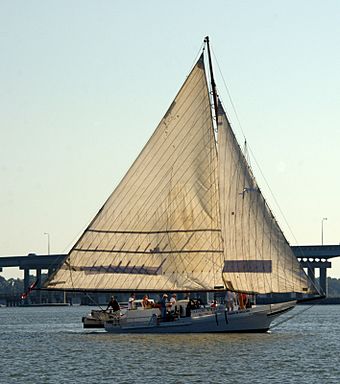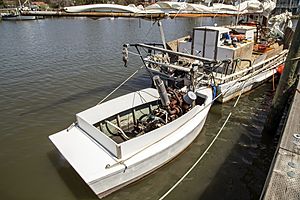Hilda M. Willing (skipjack) facts for kids
|
Hilda M. Willing
|
|
 |
|
| Location | Deal Island Harbor, Chance, Maryland |
|---|---|
| Built | 1905 |
| MPS | Chesapeake Bay Skipjack Fleet TR |
| NRHP reference No. | 85001089 |
Quick facts for kids Significant dates |
|
| Added to NRHP | May 16, 1985 |
| Designated NHL | April 19, 1994 |
Hilda M. Willing is a special kind of boat called a skipjack. She was built way back in 1905 in Oriole, Maryland, near the Chesapeake Bay. In 1994, she was named a National Historic Landmark, which means she's a very important piece of history! Even though she's a smaller skipjack, the Willing is known for being an excellent sailboat. Today, her home port is Tilghman Island, Maryland.
Contents
The History of the Hilda M. Willing
The Hilda M. Willing was built in 1905 in Oriole, Maryland. This town is located on the Manokin River, which flows into Tangier Sound in Somerset County, Maryland. When she was first built, her home port was Crisfield, Maryland.
Over the years, the Willing had many owners. In 1926, Samuel L. Laird owned her. He sold her to Thornton Webster in 1927. Then, in 1929, Roland Bozman bought her. Later, R.E. Hoffman owned the Willing, and by 1941, Addie M. Jones was her owner.
A New Life for the Willing
In 1943, T. Rayner Graham owned the boat, but he left her in Annapolis, Maryland. Luckily, Leslie Pope from Oxford, Maryland bought her for only $400! He moved her to Cambridge, Maryland.
In 1947, Robert F. "Pete" Sweitzer bought the Willing for $1600. Sweitzer owned the boat for many years, even into the 1990s. He was very good at taking care of her and did most of the repair work himself.
Modernizing the Skipjack
Pete Sweitzer made some important changes to the Willing. He was the first person to use a car engine instead of the older, single-cylinder engines to power the boat's dredging equipment. Dredging is how skipjacks collect oysters from the bottom of the bay.
Because of this new engine, Sweitzer could make the boat's sides about 8 inches (20 cm) taller. This made the Willing more stable in the water. He also made the main pole (called the boom) longer and changed the centerboard, which helps the boat steer. He even added a small fin (called a skeg) to the bottom of the boat and made the mast stand straight up instead of leaning back.
In November 2011, the Hilda M. Willing returned to the Eastern Shore of Maryland. She was used for dredging until 2014 by Captain David Whitelock. Later in 2014, Wade H. Murphy III bought her. He still uses her for dredging out of Tilghman Island, Maryland.
Why the Willing is a Great Sailboat
The Hilda M. Willing is known for being one of the best sailing boats in the entire skipjack fleet. People say she is the only skipjack that can turn around without needing to use her centerboard. She can also dredge for oysters even when the winds are strong, without needing a special front sail (called a jib).
What the Hilda M. Willing Looks Like
The Willing is about 40 feet (12 m) long, which is like the length of a school bus. She is about 14 feet (4.3 m) wide and sits about 3.08 feet (0.94 m) deep in the water.
Key Features of the Boat
She has a classic "clipper bow," which is a sharp, curved front end. The back of the boat is flat and square, called a "transom." The Willing also has a special block at the back for a "pushboat." A pushboat is a smaller boat that can help push the skipjack when there isn't enough wind for sailing.
A long wooden plank, called the "king plank," runs from the front of the boat past the mast. There's a small cabin on deck, called a "doghouse," which gives a little extra headroom in the otherwise very low cabin below deck (only about 2.5 feet (0.76 m) high!). At the back, a box holds the hydraulic steering system that Pete Sweitzer installed. There are also special cranes (called davits) hanging over the back to hold the pushboat.
The Willing has a main sail that is shaped like a triangle, called a "jib-headed mainsail," and one large front sail, or "jib." She has dredging equipment on both sides of the boat, which share one engine to operate.




